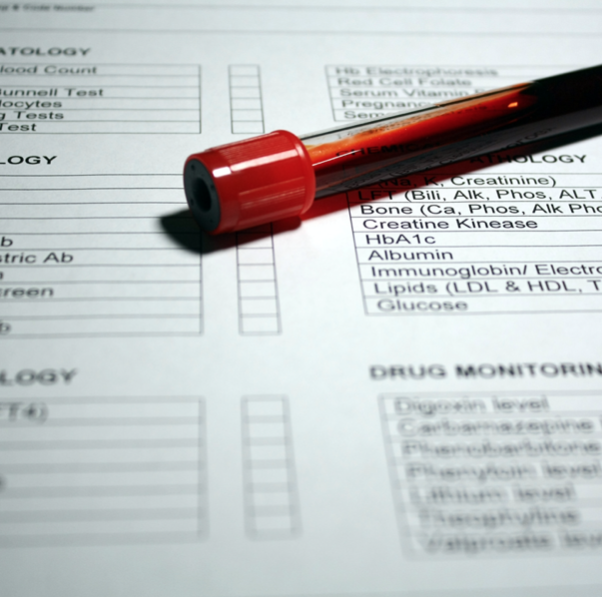- Fast results
- 4,000+ locations
- 4.8 star rating
Need Help? (888) GET LABS


This article is Medically Approved ✓ by Dr. Edward Salko
Getting tested is a crucial part of keeping optimum health and wellness. Sure, the procedure may sound terrifying for some, especially when blood tests are involved.
Nonetheless, blood testing presents essential information about diseases and your risks of developing specific ones.
Evaluating blood samples can detect changes in the blood components and identify critical imbalances in the chemicals produced by organs. Knowing these alterations can save you from worsening conditions.
Find out which blood tests you should secure in the following few lines.

In a typical setting, your doctor will order a blood test based on the symptoms you present. Likewise, a blood test will also be required during a routine check-up or physical exam.
While blood testing is often associated with verifying a specific condition in light of occurring signs and symptoms, healthy people should also get tested at least once a year.
Regular testing is a preventive measure that allows the detection of certain diseases before they escalate into a life-threatening condition.
So, if you want to increase your longevity and live life to the fullest, consider taking essential blood works to screen your health.
A blood test begins with the extraction of blood samples. It can be done in the following ways:

The blood sample is drawn from the capillary of the finger via a tiny skin puncture. This method is often done when the test requires a small amount of blood. Some tests, especially over-the-counter ones, allow you to take a finger-pricking test on your own, following the instructions religiously.
With this method, the blood sample comes from the vein. Medical professionals perform the collection as it requires the use of a needle and syringe.
Performing an arterial blood sampling is called for when analyzing gases in the bloodstream like oxygen and carbon dioxide. The sample is drawn from the artery carrying the oxygenated blood.
Once your sample is collected, it will be sent to a laboratory or medical facility for analysis. The turnaround of the results depends on the type of blood test. But when it is ready, your doctor will be able to perform a proper diagnosis of your condition and prescribe the right medication and treatment plan.
You can also opt to order blood tests online through Personalabs. Simply create an account and choose from a wide array of blood tests that you need.
Now unto the necessary blood tests that can save your health before it’s too late.

A complete blood count is ordered to check if there have been any changes in the blood count. It measures the number of blood components and determines if they fall in the normal range.
The test involves the three basic types of blood cells:
The function of the red blood cells is to deliver oxygen to the body’s different cells and collect carbon dioxide for removal.
In a CBC, two components of the RBC are measured: hemoglobin and hematocrit.
Hemoglobin is a protein that carries oxygen. On the other hand, hematocrit is the ratio of the RBCs in the blood.
White blood cells are responsible for fighting off disease-causing microorganisms and proteins. In a CBC, the number of WBCs is measured, and the types are identified.
When you have a wound or any tear in the skin, blood clotting is necessary to stop the bleeding. Blood clotting, also known as coagulation, is a function performed by the platelets.
A CBC is a standard inclusion in a routine clinical exam. As a general screening procedure, it is often used to assess your overall wellbeing and provide baseline information about your health.
Additionally, it is ordered to diagnose a spectrum of health issues. It is also involved in monitoring an already diagnosed condition and corresponding treatment.
The results of a CBC can be suggestive of a developing disease. However, since it is relatively wide-ranging, it may not be enough to diagnose a specific condition.
Nonetheless, for other health problems directly involving blood health, a CBC may be enough to assign treatment.
Here are some disorders and health conditions uncovered through CBC.
With a lipid panel, you can measure the level of lipids in your blood. Lipids are organic molecules that do not interact with water like oils, fats, hormones, and steroids.
But with a lipid panel, the tests are limited to the following:
HDL cholesterol is often referred to as the “good cholesterol” primarily because it functions to remove excess fats from the blood and takes them back to the liver for disposal.
LDL is dubbed as the “bad cholesterol.” When LDL there is too much LDL in the blood, it can accumulate in the walls of the blood vessels. This build-up can constrict the passageway of the blood.
Talking about total cholesterol refers to all types of cholesterol, whether it’s LDL, HDL, or other lipids.
Triglycerides are fats coming from the food we eat. They are derived from excess calories that your body does not need. Thereby, they usually accumulate for storage in case you run short of energy sources.
A Lipid panel is recommended for adults over 20, especially those who have a family history of cardiovascular diseases. It is ideal to take blood tests at least once every five years.
Children and teenagers can also take lipid blood tests, especially those who suffer from obesity.
With adults, the following lipid blood tests results are considered within the normal range:
For HDL, the higher the number, the better. It means that you have much good cholesterol that can aid in managing the damaging lipids.
On the other hand, it would be ideal if LDL, total cholesterol, and triglycerides are in even lower amounts.
Results that go outside the standard range can be suggestive of high risks or developing disorders like the following:
The basic metabolic panel (BMP) contains eight blood tests that measure the state of your metabolism. In turn, it evaluates the function of vital organs like the kidneys and pancreas.
Here are the tests included in BMP.
This is the accumulated waste product from the blood filtered by the kidneys. High amounts of BUN may indicate kidney problems.
Bicarbonate keeps the acid-base balance in the body. Therefore, healthy levels of bicarbonate or CO2 imply health functions of the lungs and kidneys.
Calcium is an essential mineral that plays vital roles in bone and teeth formation, blood clotting, proper functioning of the nerves, heart, muscles, and hormone production. Therefore, inadequate calcium may indicate issues in the bone, kidneys, and parathyroid glands.
Creatinine is another waste product filtered by the kidneys. It is produced in the muscles. Much like BUN, increased levels of creatinine may suggest abnormal functions of the kidneys.
Chloride is an electrolyte that helps normalize the amount of fluid and maintains the pH balance in the body.
Glucose is a type of carbohydrate that acts as the primary source of energy for the cells. Too much or too little glucose in the blood disrupts multiple functions that could lead to life-long diseases like type 2 diabetes.
Potassium plays a role in the exchange of messages between the nerve and the muscles. It also helps cells absorb more nutrients and expel waste products.
Sodium works to keep the balance between water and electrolytes in the body. It is also vital in the functions of the nerves and muscles.
BMP is a regular part of a routine health examination. It is also used to monitor several health conditions and treatment processes.
Abnormal results of the BMP may indicate the development or risks for diseases like:
A comprehensive metabolic panel encompasses the eight blood tests in the BMP with six more tests.
All in all, CMP contains 14 tests which include tests for these substances:
Albumin is a protein produced by the liver. It functions to keep fluid intact in the bloodstream allowing the delivery of substances like enzymes and hormones to various tissues. Low albumin suggests problems in the liver or kidneys.
This is an enzyme commonly found in the liver and kidney. Therefore, an elevated ALT may indicate liver damage.
ALP is another enzyme found in the liver as well as the bones and the digestive organs. High levels of ALP may suggest bone disorders or liver disease. Like other enzymes, ALP will leak into the bloodstream when there is critical damage to the liver.
AST is also an enzyme produced in the liver and heart. Therefore, when there are damages in the muscles or liver, a large amount of AST is released into the bloodstream.
Bilirubin is a yellow pigment created during the normal breakdown of the heme component of hemoglobin.
Hemoglobin is the protein carrying oxygen in RBCs. Exceeding levels of bilirubin may indicate liver or bile duct problems.
When talking about total protein, it encompasses albumin and other types of proteins in the blood. Protein is a macromolecule that has significant roles in cellular growth, repair, and other fundamental processes.
Like BMP, CMP is usually ordered during a routine medical examination. In the same way, it is used to diagnose metabolic conditions, particularly problems in the liver. Moreover, it is also used to monitor and regulate medications and treatment plans.
On top of the disorders measured by the eight blood tests included in both BMP and CMP, the latter provides essential information in the diagnosis of the following:

People are often hesitant to undergo blood testing mainly because they are frightened of the result. However, the right mindset should be; the earlier you get tested, the earlier you can get the proper treatment.
These four essential blood tests are used in routine health examinations for an important reason. They all reveal your health’s true status, which allows your doctor to look into your risks for certain diseases.
If you value your health, make sure to take these blood tests and consult with your doctor regularly.
And if you like to secure them through the easiest way possible, consider ordering the blood tests online.

© Copyright 2025 Personalabs. All Rights Reserved.